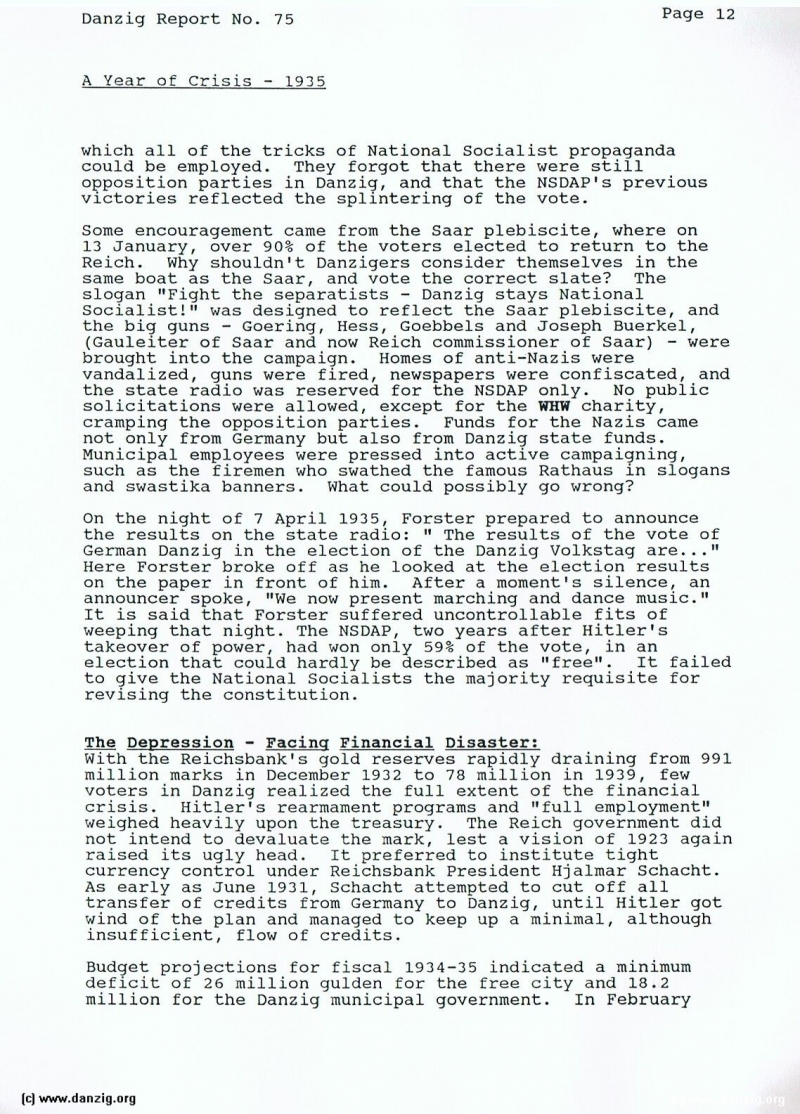
A Year of Crisis — 1935
which all of the tricks of National Socialist propaganda could be employed. They forgot that there were still opposition parties in Danzic, and that the NSDAP’s previous victories reflected the splintering of the vote.
Some encouragement came from the Saar plebiscite, where on 13 January, over 90% of the voters elected to return to the Reich. Why shouldn’t Danzigers consider themselves in the same boat as the Saar, and vote the correct slate? The slogan “Fight the separatists — Danzig stays National Socialist!” was designed to reflect the Saar plebiscite, and the big guns - Goering, Hess, Goebbels and Joseph Buerkel, (Gauleiter of Saar and now Reich commissioner of Saar) — were brought into the campaign. Homes of anti—Nazis were vandalized, guns were fired, newspapers were confiscated, and the state radio was reserved for the NSDAP only. No public solicitations were allowed, except for the WHW charity, cramping the opposition parties. Funds for the Nazis came not only from Germany but also from Danzig state funds. Municipal employees were pressed into active campaigning, such as the firemen who swathed the famous Rathaus in slogans and swastika banners. What could possibly go wrong?
On the night of 7 April 1935, Forster prepared to announce the results on the state radio: “ The results of the vote of German Danzig in the election of the Danzig Volkstag are. . .“ Here Forster broke off as he looked at the election results on the paper in front of him. After a moment’s silence, an announcer spoke, “We now present marching and dance music.” It is said that Forster suffered uncontrollable fits of weeping that night. The NSDAP, two years after Hitler’s takeover of power, had won only 59% of the vote, in an election that could hardly be described as “free”. It failed to give the National Socialists the majority requisite for revising the constitution.
The Depression - Facing Financial Disaster:
With the Reichsbank’s gold reserves rapidly draining from 991 million marks in December 1932 to 78 million in 1939, few voters in Danzig realized the full extent of the financial crisis. Hitler’s rearmament programs and “full employment” weighed heavily upon the treasury. The Reich government did not intend to devaluate the mark, lest a vision of 1923 again raised its ugly head. It preferred to institute tight currency control under Reichsbank President Hjalmar Schacht. As early as June 1931, Schacht attempted to cut off all transfer of credits from Germany to Danzig, until Hitler got wind of the plan and managed to keep up a minimal, although insufficient, flow of credits.
Budget projections for fiscal 1934-35 indicated a minimum deficit of 26 million gulden for the free city and 18.2 million for the Danzig municipal government. In February
Danzig Report Vol. 1 - Nr. 75 - April - May - June - 1992, Page 12.
Hits: 3267
Added: 02/07/2015
Copyright: 2025 Danzig.org

